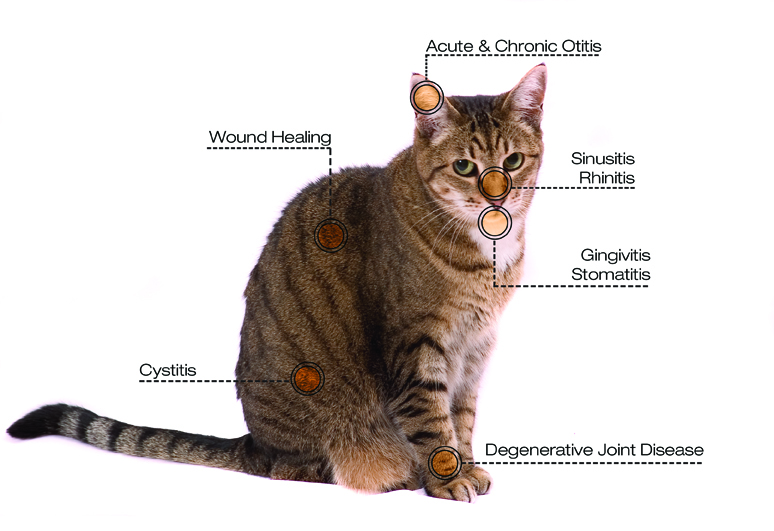Learn tips about Class IV laser therapy and other health related topics on the Companion Therapy Lasers blog! Check back weekly for updated posts.
“Canine Validation – Why Is It Important?”
 In previous blogs, we have explored a general knowledge of Platelet Rich Plasma, Stem Cells and the indications for which they can be used. Now, let’s take a look at the systems that make these therapies possible and the importance of using a system validated for use in canines.
In previous blogs, we have explored a general knowledge of Platelet Rich Plasma, Stem Cells and the indications for which they can be used. Now, let’s take a look at the systems that make these therapies possible and the importance of using a system validated for use in canines.
The general definition of validation is to “confirm that a product or a service meets the needs of its users”. In the veterinary practice that is utilizing regenerative medicine, whether it be PRP or Stem Cell therapy (or a combination of the two), the goal is to use a product that will result in having consistent therapeutic effects. With Platelet Rich Plasma, that means using a final PRP product that has a 5-7 fold concentration of platelets and a reduction of less than desirable or harmful cell types (red blood cells and neutrophils). For Stem Cell isolations, it means producing a product that contains active stem cells that can divide and differentiate into the tissue we are intending to heal. Additionally, the process by which these final products are obtained must be reproducible with little variation between users and patients.
Why do we need a system to be specifically validated for canine patients? To meet the goals of the veterinary practitioner, it is imperative that the system being used has been optimized to process samples for the intended patients. For the equine practitioner, that means using a system that was designed to process samples collected from a horse. Similarly, for the small animal practitioner, that means using a system that was designed process samples for dogs. But why can’t a small animal practitioner use a system that was originally intended for horses or humans? After all, blood is blood, right?
It is important to understand the different characteristics of blood and the species that blood sample belongs to. Densities, volumes and shapes of the cells all come into consideration when designing a processing protocol for isolating a select cell type. When processing for Platelet Rich Plasma, this means the method of separation needs to be specific for the characteristics of the cells in the particular species. What may work for a horse, may not work for a dog, human, etc. It is important that the system being used to process the samples has taken all of the above characteristics into consideration and is specifically designed to process the samples accordingly. It is equally important that the system has been validated by third party evaluation to provide the end product that has been marketed.
For more information on the Companion Regenerative Therapies System or to view the published multicenter validation study on canine PRP, please click here. Stayed tuned for our next blog where we will take a closer look at the different cell types and their roles in the PRP sample.
“Why My Cats and I Love Laser Therapy”
Guest Post by Diane Miller
There is something about owning a cat that makes us different. It’s a cross between owning a pet and being owned by your pet. My dogs revolve around my schedule and are willing to accept it. I, on the other hand, am at the mercy of my feline friends and think nothing of working around them. I can’t begin to count the number of times I have held off on laundry because someone is in the basket sleeping, or making the bed, or working on the computer, and the list is endless. My cats make a wimp of me with their demands for attention, food, stimulation, etc., and I think nothing of providing it the moment they demand it. For a control freak like me, that’s a tough admission.
Binky and Orca are brothers and are 14 years old now and I call them “The Boys”. I raised them from a bottle when their mother was hit by a car. I am in an area where they can go out safely for a little while, hang in the sun, eat a little grass (to puke it up on the carpet when they come back in). A happy existence.
Taking The Boys out of their home for veterinary visits is like having two furry cannons in the car. Just one wrong move and they explodes in teeth and claws. Not to mention the caterwauling. Who ever thought they would create a word to specifically cover our cats yelling in the car. Dictionary.com says the word originated in “1350-1400; Middle English cater(wawen) (equivalent to cater tomcat (< Middle Dutch) + wawen to howl, Old English wāwan to blow, said of the wind) + waul, variant of wail”. Any of us driving in a car with our cat for longer than 5 minutes knows firsthand what it sounds like, even if you never knew there was a word for it. So taking them to the vet is done only when needed.
Recently we acquired a feral cat community in the abandoned house next door. It has definitely put a crimp in The Boys being able to go outdoors. They usually hang at the house but some of the feral gang do too, so if their paths cross, the end result is that The Boys get their butts whipped. I have become very familiar with the veterinary term of “wound of unknown origin”. Namely, The Boys crossed paths with one of the ferals and ended up with a puncture wound in the kerfuffle. If I notice it soon enough and get him to my vet, Dr. Kathryn, before it gets infected it is a beautiful thing.
Dr. Kathryn can treat these wounds with her Companion Therapy Laser. Getting our wounds treated using laser therapy is wonderful. Dr. Kathryn cleans the wound, and then we laser it. It’s non-invasive and the treatment only takes a couple of minutes. It looks like a magic wand passing over the wound, no contact, so The Boys don’t get too stressed in the vet’s office. When we start to laser, my cat will start to relax, and sometimes he’ll even purr (read more about how animals react to laser therapy treatments). Having laser therapy helps the wounds to heal faster, they often start drying up before I even get him home. I also noticed that he doesn’t bother the wound as much so it must feel better to him as well. It usually heals very quickly with no extra vet trips needed.

Laser therapy can be used for a variety of conditions – sometime it requires contact with the skin and others times not, like with wounds. My cats really like the way it feels, and there are many applications.
Contact your veterinarian to see if laser therapy is a good fit for your pet’s condition.
“Platelet Rich Plasma- Indications For Use”
In our previous post titled “Growth Factors- What Are They and Why Are They Important?”, we took a closer look at the components that provide the benefits in Platelet Rich Plasma. Now that we have an understanding of why Platelet Rich Plasma is beneficial, it’s time to look at what conditions it can be used for.
One of the most common conditions that can be treated with Platelet Rich Plasma is osteoarthritis. Also referred to as Degenerative Joint Disease or DJD, osteoarthritis is the most common cause of lameness in dogs. It affects 1 out of 5 adult dogs and 4 out of 5 geriatric dogs (>8 years old) in North America.* Osteoarthritis is progressive and permanently deteriorates the cartilage in the joints, which can lead to painful bone-on-bone contact if left untreated. Because osteoarthritis in progressive, it is important to detect the disease in its early stages and treat it effectively to prevent further damage.
When PRP is used as a treatment for osteoarthritis, it provides several benefits to the affected joint, including:
- Increased lubrication of joint space
- Preservation of remaining cartilage
- Increased production and preservation of cellular matrix (Hyaluronic Acid, Chondroitin Sulfate, Collagen, etc.)
- Decreased inflammation (modulates inflammatory cytokines)
- Reduction in pain
Platelet Rich Plasma can also be used to treat soft tissue injuries including ligament and tendon tears. It has been shown to accelerate healing and repair of these injuries through the gradual release of its growth factors and attraction of numerous cell types to the site of injury. Additionally, it has been shown to increase tensile strength of tendons after administration, reducing the likelihood of re-injury in the area of damage. Just as with osteoarthritis, it is important to have a definitive diagnosis confirmed by either needle scope or ultrasound.
Additionally, PRP has been shown to be beneficial in the treatment of burn wounds, open wounds, certain spinal conditions and in the preparation of bone graft material. To request more information about Platelet Rich Plasma and the Companion Regenerative Therapies System, click here.
Stay tuned for next week’s post where we will go over canine system validation and why it’s important.
*Johnston SA. Osteoarthritis: Joint anatomy, physiology, and pathobiology. Vet Clin North Am Small Anim Pract. 1997, 27: 699-723.



